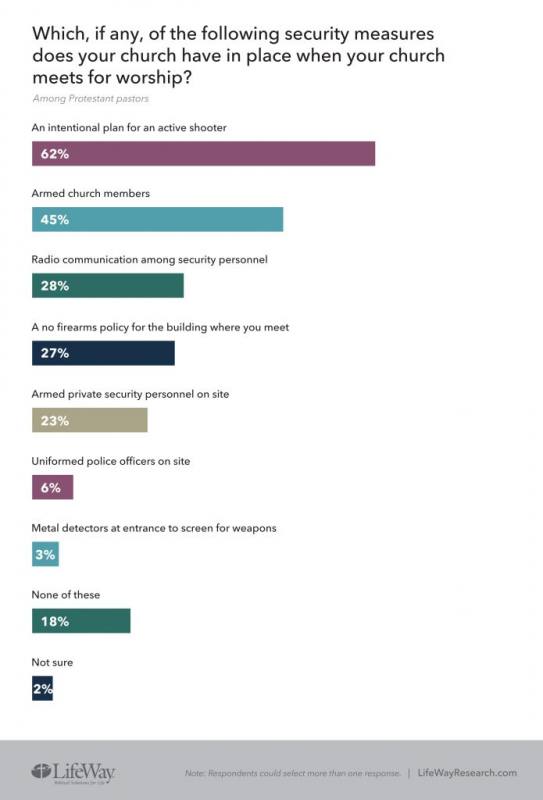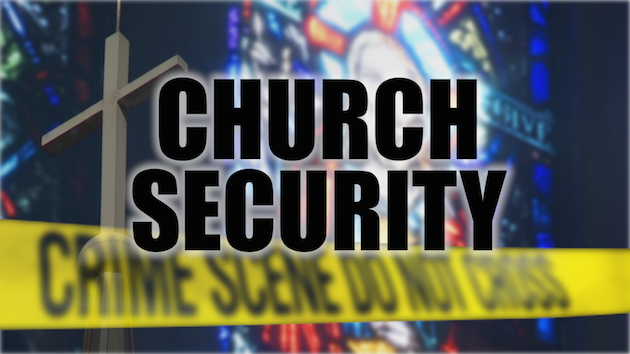In the aftermath of several high-profile church shootings, most pastors say their congregations have taken some precautions to protect those in attendance. That includes peppering armed members throughout the church.
Since 2000, 19 fatal shootings have taken place at Christian churches, while gunmen have also taken lives at other religious sites like Jewish synagogues, a Sikh temple and an Amish school.
Recently, an active shooter at a Texas church was stopped by an armed church member but not until after the shooter killed two.
That news comes as, statistically, church remains one of the safest places a person can be.
Today, around 4 in 5 pastors (80 percent) say their church has some type of security measure in place when they gather for worship, according to a survey from Nashville-based LifeWay Research.
It’s not known what the numbers are within Catholic churches.
“Churches are some of the most common gatherings in any community, and that makes them targets,” said Scott McConnell, executive director of LifeWay Research. “Most churches understand this and have responded in some way.”

Security specifics
The most common form of preparation is making an intentional plan. Almost 2 in 3 pastors (62 percent) say their church has an intentional plan for an active shooter situation.
The more people who show up to worship services each week, the more likely the church is to have made plans for a potential gunman.
Pastors of churches with 250 or more in attendance (77 percent) and those with 100 to 249 (74 percent) are more likely to have an intentional plan than those with 50 to 99 in attendance (58 percent) or those with less than 50 in their worship service each week (45 percent).
More than a quarter of churches (28 percent) have radio communication among security personnel.
African American pastors (47 percent) and pastors of other ethnicities (46 percent) are almost twice as likely as white pastors (25 percent) to take this step. That may be because of the high crime rates in urban centers, where black churches are primarily located.
The question of guns in church is very much a live debate among pastors, as close to half of pastors (45 percent) say part of their security measures include having armed church members.
Combining this with the percentages who say they have uniformed police officers or armed security personnel on site, 51 percent intentionally have firearms at their worship services as part of their security measures.
Evangelical pastors (54 percent) are more likely than mainline pastors (34 percent) to say they have armed church members.
Half of pastors in the South (51 percent) and West (46 percent) say this is the case compared to a third of those in the Northeast (33 percent).
READ: Shooter opens fire in Texas church
Pentecostal (71 percent), Baptist (65 percent) and Church of Christ pastors (53 percent) are also more likely than Methodist (32 percent), Lutheran (27 percent) and Presbyterian or Reformed pastors (27 percent) to say they have armed church members as part of their security measures.
Other churches place their emphasis on keeping all guns away from the worship service.
More than a quarter (27 percent) have a no-firearms policy for the building where they meet and 3 percent have metal detectors at entrances to screen for weapons.
African American pastors are the most likely to implement these strategies, with 50 percent saying they have a no-firearms policy and 8 percent deploying metal detectors.
Almost 1 in 5 pastors (18 percent) say their church has taken none of the precautions asked about in the survey, while 2 percent aren’t sure.
“While methods vary, most churches start with the resources they have to prepare for what they hope will never happen,” said McConnell. “With planning, a church can be prepared without being distracted or paralyzed by the threat. Pastors are trying to balance two responsibilities — protect those on the inside, while being as welcoming as possible to those on the outside.”
Police protection
The survey took place prior to the Dec. 29 shooting West Freeway Church of Christ in White Settlement, Texas, near Fort Worth. Three people died, including the gunman, who was shot by a member of the church’s security team.
Close to a quarter of Protestant pastors (23 percent) say they have armed private security on site. Additionally, 6 percent say they have uniformed police officers on site as an added security measure.
For the vast majority of churchgoers (73 percent), the presence of a uniformed policeman or security guard at church makes them feel safer, with 37 percent saying they feel much safer.
One in 5 (20 percent) aren’t sure and 8 percent say it makes them feel less safe.
African-American pastors are the most likely to say they have both armed private security personnel (41 percent) and uniformed police officers (18 percent) on site.
However, non-white churchgoers are more likely than white churchgoers to say they feel less safe at church seeing those individuals during worship services.
Around 1 in 10 non-white churchgoers (10 percent) say they feel less safe with uniformed police and security guards at church compared to 6 percent of white churchgoers.
Female churchgoers, on the other hand, are more likely than their male counterparts to say those visible individuals make them feel safer (75 percent to 69 percent).
Churches with 250 or more in attendance are the most likely to say they have armed private security personnel (43 percent) or uniformed police officers (26 percent).
Those who attend such churches are also the most likely to say seeing police officers and security guards at church make them feel safer (83 percent).
“Any organization that has relatively large gatherings of people has a responsibility for the safety of those gathered,” said McConnell. “In considering security, church leaders have to consider methods, costs, risks and how those safety measures potentially impact their ministry.”
Methodology:
The phone survey of 1,000 Protestant pastors was conducted August 30 to September 24, 2019. The calling list was a stratified random sample, drawn from a list of all Protestant churches. Quotas were used for church size.
Each interview was conducted with the senior pastor, minister or priest of the church called. Responses were weighted by region to more accurately reflect the population. The completed sample is 1,000 surveys. The sample provides 95 percent confidence that the sampling error does not exceed plus or minus 3.3 percent. Margins of error are higher in sub-groups.
The online survey of 1,002 American Protestant churchgoers was conducted September 20 to 27, 2019 using a national pre-recruited panel. Respondents were screened to include those who identified as Protestant/non-denominational and attend religious services at least once a month. Quotas and slight weights were used to balance gender, age, region, ethnicity and education to more accurately reflect the population.
The completed sample is 1,002 surveys. The sample provides 95 percent confidence that the sampling error from the panel does not exceed plus or minus 3.2 percent. Margins of error are higher in sub-groups.








